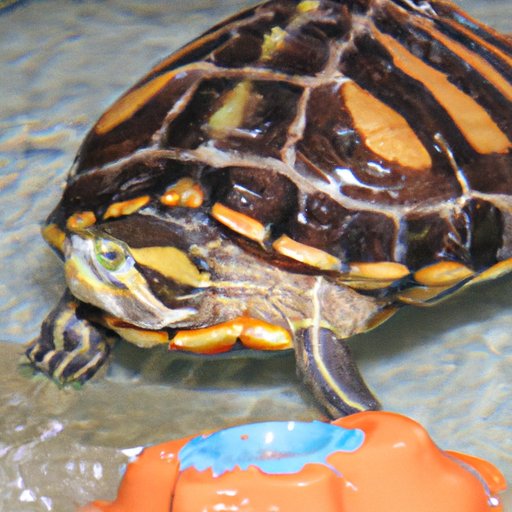Introduction
Turtles are popular pets that require a lot of special care and attention. But with the right knowledge and dedication, you can provide a safe and healthy home for your pet turtle. This article will explain the essential elements of caring for a turtle, including setting up an appropriate enclosure, maintaining the right temperature and humidity levels, feeding a balanced diet, keeping the water clean, monitoring your turtle’s health, handling with care, and giving your turtle enough time out of its tank.
Provide a Proper Enclosure
The first step in taking care of your turtle is to provide it with a suitable enclosure. The size and type of tank you choose will depend on the species of turtle you have. Generally, a larger tank is better, as it provides more space for your turtle to move around. For most aquatic turtles, a tank that is at least 10 gallons per inch of shell length is recommended. Additionally, you should make sure the tank has a secure lid to prevent your turtle from escaping.
In addition to the size of the tank, you should also consider the type of tank. Glass aquariums are the most common choice, but you can also use plastic tanks or even outdoor ponds if you have the space. Whichever type of tank you choose, make sure it is equipped with the necessary furnishings. This includes a basking area, where your turtle can rest and warm up, as well as rocks, logs, and other items for your turtle to hide in or climb on.
Create the Right Temperature and Humidity Levels
The temperature and humidity levels of your turtle’s enclosure are important for its health and wellbeing. Turtles are cold-blooded animals, which means they rely on their environment to regulate their body temperature. To ensure your turtle is comfortable, you should keep the water temperature between 75 and 85 degrees Fahrenheit, while the basking area should be kept between 85 and 95 degrees Fahrenheit.
Humidity is also important for your turtle’s health. The ideal humidity level for your turtle’s enclosure should be between 50 and 70 percent. You can measure the humidity level with a hygrometer and adjust it as needed by adding or removing water from the tank.
Feed a Balanced Diet
Your turtle’s diet is another important factor in its overall health. Turtles require a balanced diet that includes both plant and animal matter. Feeding your turtle a variety of foods will help ensure it gets all the nutrients it needs. Commercial turtle food is available, but you should also supplement your turtle’s diet with fresh fruits and vegetables, as well as live insects such as crickets and mealworms.
It is important to monitor how much your turtle eats and watch for any signs of malnutrition or obesity. Overfeeding your turtle can lead to health problems, so it is best to feed your turtle only what it can eat in five minutes. Additionally, some turtle species are carnivorous, while others are omnivorous, so you should research the nutritional needs of your particular turtle species.
Keep the Water Clean
The water in your turtle’s tank should be kept clean at all times. This means regularly changing the water and using filters to remove any debris or waste. You should replace at least 25 percent of the water in the tank each week, and you should also clean the tank and its furnishings every two weeks. Additionally, you should check the water’s pH levels and make sure they remain within the appropriate range.
Monitor Your Turtle’s Health
It is important to monitor your turtle’s health on a regular basis. Look for any signs of illness, such as changes in appetite, lethargy, or discolored skin. If you notice any of these symptoms, contact your veterinarian for advice. Regular veterinary checkups are also recommended, as your vet can identify any potential health problems before they become serious.
Handle With Care
When handling your turtle, it is important to use appropriate techniques. You should always wash your hands before and after handling your turtle, as this will help prevent the spread of bacteria and disease. When picking up your turtle, support its body with both hands, and avoid squeezing or pinching its shell. It is also important to use caution when moving your turtle, as it can easily slip out of your hands.

Give Your Turtle Enough Time Out of Its Tank
Your turtle will benefit from having plenty of time outside of its tank. This allows your turtle to explore and exercise, as well as get some much-needed mental stimulation. When you let your turtle out of its tank, it is important to supervise it at all times. Make sure it does not come into contact with any dangerous objects or substances, and do not allow it to wander too far away from its enclosure.
Conclusion
Taking care of a turtle requires patience, dedication, and knowledge. From providing a suitable enclosure to creating the right temperature and humidity levels, there are many important aspects of turtle care. Additionally, it is important to feed your turtle a balanced diet, keep its water clean, monitor its health, handle it with care, and give it enough time outside of its tank. With the right care and attention, you can create a safe and healthy home for your pet turtle.


